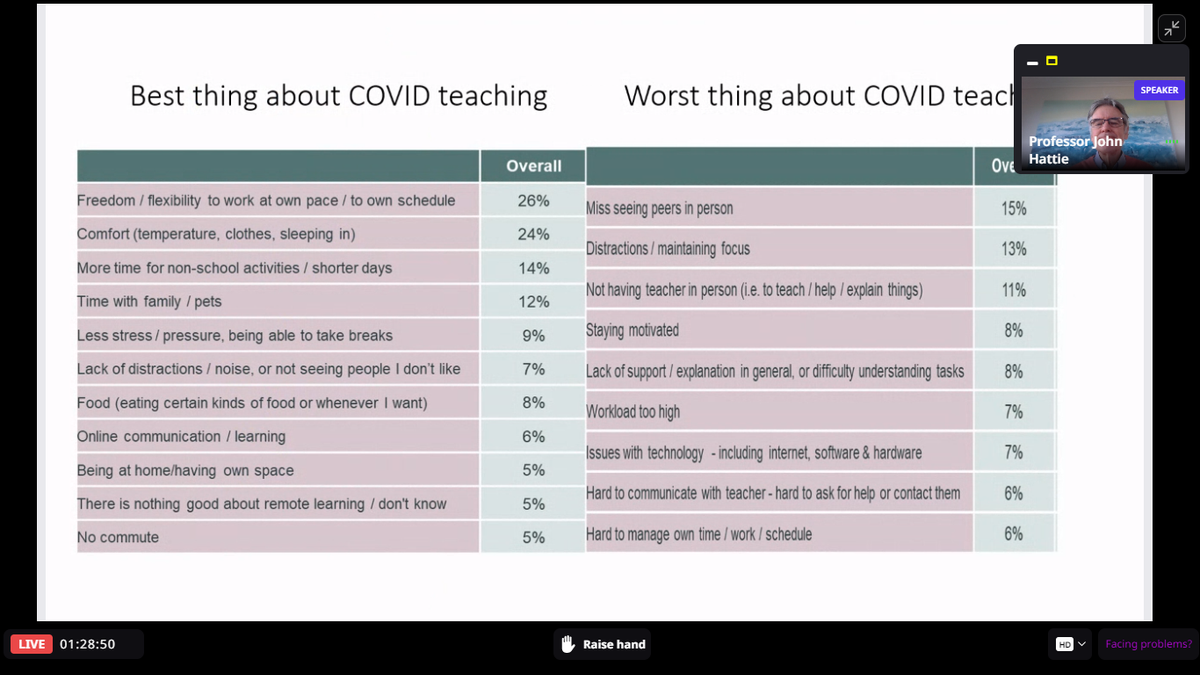Wellbeing
Student voice, agency and leadership

Wellbeing
Student voice, agency and leadership
Remote and flexible learning- an insight
As our students continue to break new ground, both academically and technologically, from their makeshift home offices, we have to ask the question ‘how is this affecting my child’?
If, like me, you have an unhealthy relationship with trawling the media (‘doom scrolling’ is the millennial term), then you will have no doubt been exposed to many polarizing opinion pieces of the impact of the pandemic on your child’s learning.
A silver lining of our current working from home orders is the ability to attend conferences over the internet and more often than not at a time, either live or recorded, that does not affect the school day. I recently heard John Hattie present as a keynote speaker at an event, with much of his work for the day centered around the impact of the pandemic on student learning.
John Hattie- A brief history
John Hattie is a Professor of Education from New Zealand and has been a professor of education and director of the Melbourne Education Research Institute at the University of Melbourne, since March 2011. He is a key proponent of evidence-based teaching. Evidence-based teaching is to teach using only those methods, which have been verified from evidence to be effective. Such evidence is based on meta-studies of what actually works in education. John is particularly notable for his work on what he terms ‘Visible Learning’, which is the world’s largest ever collection of evidence-based research into what actually works in education. He headed a team of researchers for twenty years who trawled the world for evidence about the effectiveness of different teaching interventions. The good news from these studies is that 95% or more of things that teachers do to enhance the achievement of students in the classroom work. Taking this evidence though, which he presents as a continuum of achievement, his fundamental interest has been to pull out and share the most effective of these teaching interventions.
What Hattie presented was, as you would expect from an academic, entirely evidence based. I hope it will provide you with a starting point to determine your child’s ongoing needs in this current educational climate, as opposed to my aforementioned doom scrolling habits.
Some key messages that I took from the data presented relate to the perception of impact on students and learning and equally what students themselves actually felt- a message I feel is often lost in the media.
Firstly, a study commissioned by the NSW Dept. of Education:


Whilst data and research into the effect of the pandemic is in its infancy, and noting that NSW in 2020 was a very different place to Melbourne, it is encouraging to see this statement as the key summary of their research.
A comparable model produced in Victoria based upon internal survey data from 60 schools allowed the study to highlight the main negatives/positives that have presented for students and their learning (the vast majority of data being supplied by parents):




At this stage it is important to note that every child and every family are unique and are facing this pandemic in their own circumstantial manner, as such this data is not a value judgement or critique of the individual but rather something that can perhaps provide guidance or thought.
The areas that we see highlighted as positives relate to student environment and choice/flexibility. Whilst a return to school will remove the opportunity to enjoy creature comforts and a relaxed start to the day, it does not preclude the need to dismiss the role of freedom in learning; as educators we ask ourselves how we can take this positive impact on learning and create greater voice and agency in onsite learning programs for our students.
The largest negative effect score that we observe here is that which relates to lack of peer face-to-face interaction. Whilst we continue to adapt our remote learning programs to try and achieve a sense of connectedness and the ability to collaborate more authentically we must ultimately acknowledge that humans are social beings- and as such our return to onsite learning must prioritize wellbeing and connection for all: students, teachers and parents.
To conclude…
These observations are designed to give you a balanced snapshot of the perceptions versus the available evidence of remote and flexible learning. There are many caveats including the current extended lockdown, state data being a broad range, Boroondara Park being a school community with many advantages in comparison to others and ultimately the individual impact of the pandemic from household to household. Perhaps these thoughts do little for you, or perhaps they provide an insight; maybe they give you a chance to talk with your child and determine their ‘plus and minus’ ideas on their remote learning experience and how we can help their individual needs as we move forward.
Compiled by Nick King
Learning Specialist- Student Voice, Agency and Wellbeing